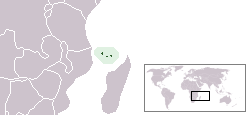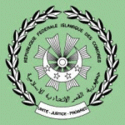Comoros
|
|
The Union of Comoros (until 2002 the Islamic Federal Republic of the Comoros) is principally a three-island country in southern Africa, situated at the northern end of the Mozambique Channel in the Indian Ocean, between northern Madagascar and northern Mozambique. The country consists of three volcanic islands: Grande Comore, Moheli and Anjouan, while the nearby island of Mayotte is claimed by Comoros but declined independence from France. The country's territory also encompasses many smaller islands. Its name was adopted from the word al-Khamar, meaning 'island of small moon,' as seen depicted on its flag.
| |||||
| Motto: Unité - Justice - Progrès (French, "Unity, justice, progress") | |||||
| Anthem: Udzima wa ya Masiwa | |||||

| |||||
| Capital | Moroni Template:Coor dm | ||||
| Largest city | Moroni | ||||
| Official languages | Shikomor, Arabic, French | ||||
| Government | — Col. Azali Assoumani | ||||
| Independence Declared Recognised | From France 1975 1975 | ||||
| Area • Total • Water (%) | 2,170 km² (167th) Negligible | ||||
| Population • 2002 est. • n/a census • Density | 596,202 (158th) n/a 275/km² (275) | ||||
| GDP (PPP) • Total • Per capita | n/a estimate n/a (n/a) n/a (n/a) | ||||
| Currency | Comorian franc (KMF)
| ||||
| Time zone • Summer (DST) | (UTC+3) observed? (UTC?) | ||||
| Internet TLD | .km | ||||
| Calling code | +269
| ||||
| Contents |
History
Main article: History of Comoros
Over the centuries, the islands of Comoros were invaded by a succession of diverse groups from the coast of Africa, the Persian Gulf, Indonesia, and Madagascar. Portuguese explorers visited the archipelago in 1505.
Between 1841 and 1912, France established colonial rule and placed the islands under the administration of the governor general of Madagascar. Later, French settlers, French-owned companies, and wealthy Arab merchants established a plantation-based economy that now uses about one-third of the land for export crops. Agreement was reached with France in 1973 for Comoros to become independent in 1978. On July 6, 1975, however, the Comorian parliament passed a resolution declaring independence. The deputies of Mayotte, which stayed under French control, abstained. In two referendums, in December 1974 and February 1976, the population of Mayotte voted against independence from France (by 63.8% and 99.4% respectively).
In 1997, the islands of Anjouan and Moheli declared their independence from Comoros. A subsequent attempt by the government to reestablish control over the rebellious islands by force failed, and presently the African Union is brokering negotiations to effect a reconciliation.
Politics
Main article: Politics of Comoros
The political situation in Comoros has been extremely fluid since the country's independence in 1975, subject to the volatility of coups and political insurrection.
Colonel Azali Assoumani seized power in a bloodless coup in April 1999, overthrowing Interim President Tadjiddine Ben Said Massounde, who himself had held the office since the strange death of democratically elected President Mohamed Taki Abdoulkarim in November, 1998.
In May 1999, Azali decreed a constitution that gave him both executive and legislative powers. Bowing somewhat to international criticism, Azali appointed a civilian Prime Minister, Bainrifi Tarmidi, in December 1999; however, Azali retained the mantle of Head of State and army Commander. In December 2000, Azali named a new civilian Prime Minister, Hamada Madi, and formed a new civilian Cabinet.
On February 17, 2000, representatives of the government, the Anjouan separatists, the political opposition, and civil society organizations signed a "Framework Accord for Reconciliation in Comoros," brokered by the Organization for African Unity (OAU). The accord called to develop a "New Comorian Entity" with a new constitution.
The constitution gives Moheli, Anjouan and Grande Comore the right to govern most of their own affairs with their own presidents. In addition, a federal president and parliament sit on the largest island, Grande Comore. This federal presidency is rotated between the islands' presidents. General elections were held in 2004, in which federal president Azali suffered a major setback by only winning 6 of the 18 seats in the National assembly, the other going to the supporters of the presidents of the semi-autonomous islands.
Geography
Cn-map.png
Main article: Geography of Comoros
Comoros is formed by three of the four main islands in the Comoros Archipelago; the fourth is the French territory of Mayotte. The archipelago is situated in the Indian Ocean, between the African coast and Madagascar. The interior of the volcanic islands vary from steep mountains to low hills. Le Karthala (2316 m) on Grand Comore is an active volcano.
Economy
Main article: Economy of Comoros
Comoros is one of the poorest countries in the world. Agriculture, including fishing, hunting, and forestry, is the leading sector of the economy.
Comoros has inadequate transportation system, a young and rapidly increasing population, and few natural resources. The low educational level of the labor force contributes to a subsistence level of economic activity, high unemployment, and a heavy dependence on foreign grants and technical assistance. Agriculture contributes 40% to GDP, employs 80% of the labor force, and provides most of the exports.
The government is struggling to upgrade education and technical training, to privatize commercial and industrial enterprises, to improve health services, to diversify exports, to promote tourism, and to reduce the high population growth rate.
Demographics
Main article: Demographics of Comoros
The Comorians inhabiting Grande Comore, Anjouan, and Moheli (86% of the population) share African-Arab origins. Islam is the dominant religion, and Koranic schools for children reinforce its influence. Although Arab culture is firmly established throughout the archipelago, a substantial minority of the citizens of Mayotte (the Mahorais) are Catholic and have been strongly influenced by French culture.
The most common language is Shikomor, a Swahili dialect. French, Arabic and Malagasy also are spoken. About 57% of the population is literate in the Latin alphabet, more with the Arabic alphabet.
Culture
Main article: Culture of Comoros
See also:
Miscellaneous topics
- Communications in Comoros
- Transportation in Comoros
- Military of Comoros
- Foreign relations of Comoros
- List of Presidents of Comoros
External links
Template:Portal Template:Commonscat Template:Wiktionary
News
- allAfrica - Comoros (http://allafrica.com/comoros/) news headline links
- Al-Watwan (http://www.comores-online.com/al-watwan/) weekly newspaper
Overviews
- BBC News - Country Profile: Comores (http://news.bbc.co.uk/1/hi/world/africa/country_profiles/1070727.stm)
- CIA World Factbook - Comoros (http://www.cia.gov/cia/publications/factbook/geos/cn.html)
- Library of Congress Country Study - Comoros (http://lcweb2.loc.gov/frd/cs/kmtoc.html) data as of August 1994
Directories
- Arab Gateway - Comoros (http://www.al-bab.com/arab/countries/comoros.htm)
- LookSmart - Comoros (http://search.looksmart.com/p/browse/us1/us317836/us317916/us559898/us559899/us10065675/us559911/) directory category
- MweziNet (http://www.comores-online.com/accueilgb.htm) directory and encyclopedia
- Open Directory Project - Comoros (http://dmoz.org/Regional/Africa/Comoros/)
- Stanford University - Africa South of the Sahara: Comoros (http://www-sul.stanford.edu/depts/ssrg/africa/comoros.html) directory category
- The Index on Africa - Comoros (http://www.afrika.no/index/Countries/Comoros/) directory category
- University of Pennsylvania - African Studies Center: Comoros (http://www.sas.upenn.edu/African_Studies/Country_Specific/Comoros.html) directory category
- Yahoo! - Comoros (http://dir.yahoo.com/Regional/Countries/Comoros/) directory category
Tourism
Other
- Comores Online (http://www.comores-online.com/accueilgb.htm) portal
- U.S. State Dep. Background on Comoros (http://www.state.gov/r/pa/ei/bgn/5236.htm)
- Republican party of Comoros (http://www.chez.com/prc/)
- The islands of Comoros (http://www.ksu.edu/sasw/comoros/comoros.html)
- Report from IRIN (UN office for the coördination of Humanitarian Affairs) (http://www.irinnews.org/report.asp?ReportID=40804&SelectRegion=Southern_Africa)
- www.comoros-online.com - First information website on Comoros - Association MWEZINET "La passion des Comores" (http://www.comoros-online.com)
- Willgoto Comoros (http://www.willgoto.com/categories.aspx?Destination=9&Langue=1) travel guide
| Countries in Africa | ||
|
Algeria | Angola | Benin | Botswana | Burkina Faso | Burundi | Cameroon | Cape Verde | Central African Republic | Chad | Comoros | Democratic Republic of the Congo | Republic of the Congo | Côte d'Ivoire | Djibouti | Egypt | Equatorial Guinea | Eritrea | Ethiopia | Gabon | The Gambia | Ghana | Guinea | Guinea-Bissau | Kenya | Lesotho | Liberia | Libya | Madagascar | Malawi | Mali | Mauritania | Mauritius | Morocco | Mozambique | Namibia | Niger | Nigeria | Rwanda | São Tomé and Príncipe | Senegal | Seychelles | Sierra Leone | Somalia | Somaliland | South Africa | Sudan | Swaziland | Tanzania | Togo | Tunisia | Uganda | Zambia | Zimbabwe | Western Sahara | ||
| Dependencies: Canary Islands | Ceuta and Melilla | Madeira Islands | Mayotte | Réunion | Saint Helena and dependencies | ||
bn:কোমোরোস ca:Comores da:Comorerne de:Komoren et:Komoorid es:Comoras eo:Komoroj fa:کومور fr:Comores ko:코모로 id:Komoro ia:Comoras it:Comore he:קומורו lv:Komoru salas lt:Komorai ms:Comoros nl:Comoren nds:Komoren ja:コモロ no:Komorene pl:Komory pt:Comores ru:Коморские острова sa:कोमोरोस sk:Komory sl:Komori fi:Komorit sv:Komorerna uk:Коморскі острови zh:葛摩


